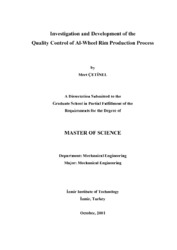Please use this identifier to cite or link to this item:
https://hdl.handle.net/11147/3731Full metadata record
| DC Field | Value | Language |
|---|---|---|
| dc.contributor.advisor | Aygün, Hacer | - |
| dc.contributor.author | Çetinel, Mert | - |
| dc.date.accessioned | 2014-07-22T13:52:14Z | - |
| dc.date.available | 2014-07-22T13:52:14Z | - |
| dc.date.issued | 2001 | - |
| dc.identifier.uri | http://hdl.handle.net/11147/3731 | - |
| dc.description | Thesis (Master)--Izmir Institute of Technology, Mechanical Engineering, Izmir, 2001 | en_US |
| dc.description | Includes bibliographical references (leaves: 82-85) | en_US |
| dc.description | Text in English; Abstract: Turkish and English | en_US |
| dc.description | viii, 85 leaves | en_US |
| dc.description.abstract | With the increasing use of aluminum wheels in automotive industry, the aluminum foundry industry had to focus on the quality and reliability of the products.To produce good quality aluminum cast wheels, defects must be minimized and the quality of each production step must be controlled.The main topic of this study was to investigate the production line of a big aluminum wheel foundry and improve the quality of production using quality control tools. The production parameter data and real-time x-ray inspection results have been collected. Parameters of the machines that are involved with the production and the results of testing equipment and thermal analyzer have been recorded.To obtain effective feedback during process, a proposed flow chart of the wheel production line was developed. The process parameters which have influences on the quality of wheel were determined by using Fishbone diagrams. According to the results of real-time radioscopic inspection, it was concluded that the main defects that occur on Al wheel are gas holes, porosity and shrinkage. The locations of the defects were identified with results of inspection and evaluated by using the charts. To eliminate these defects, some outstanding remedies are given in the flow chart of Al wheel production.A predicted equation between hydrogen content and density index of gas holes in molten metal was obtained by using the Least Square Method. Analysis of variance for the single factor showed that degassing time affects the hydrogen content in the molten metal. Finally, hydrogen content and the molten metal temperature relationship was investigated by a graphical method. | en_US |
| dc.language.iso | en | en_US |
| dc.publisher | Izmir Institute of Technology | en_US |
| dc.rights | info:eu-repo/semantics/openAccess | en_US |
| dc.subject.lcc | TJ181.5 C47 2001 | en |
| dc.subject.lcsh | Wheels | en |
| dc.subject.lcsh | Aluminum alloys | en |
| dc.title | Investigation and Development of the Quality Control of Al-Wheel Rim Production Process | en_US |
| dc.type | Master Thesis | en_US |
| dc.institutionauthor | Çetinel, Mert | - |
| dc.department | Thesis (Master)--İzmir Institute of Technology, Mechanical Engineering | en_US |
| dc.relation.publicationcategory | Tez | en_US |
| dc.identifier.wosquality | N/A | - |
| dc.identifier.scopusquality | N/A | - |
| item.cerifentitytype | Publications | - |
| item.openairecristype | http://purl.org/coar/resource_type/c_18cf | - |
| item.languageiso639-1 | en | - |
| item.openairetype | Master Thesis | - |
| item.fulltext | With Fulltext | - |
| item.grantfulltext | open | - |
| Appears in Collections: | Master Degree / Yüksek Lisans Tezleri | |
Files in This Item:
| File | Description | Size | Format | |
|---|---|---|---|---|
| T000572.pdf | MasterThesis | 1.37 MB | Adobe PDF |  View/Open |
CORE Recommender
Page view(s)
348
checked on May 12, 2025
Download(s)
210
checked on May 12, 2025
Google ScholarTM
Check
Items in GCRIS Repository are protected by copyright, with all rights reserved, unless otherwise indicated.